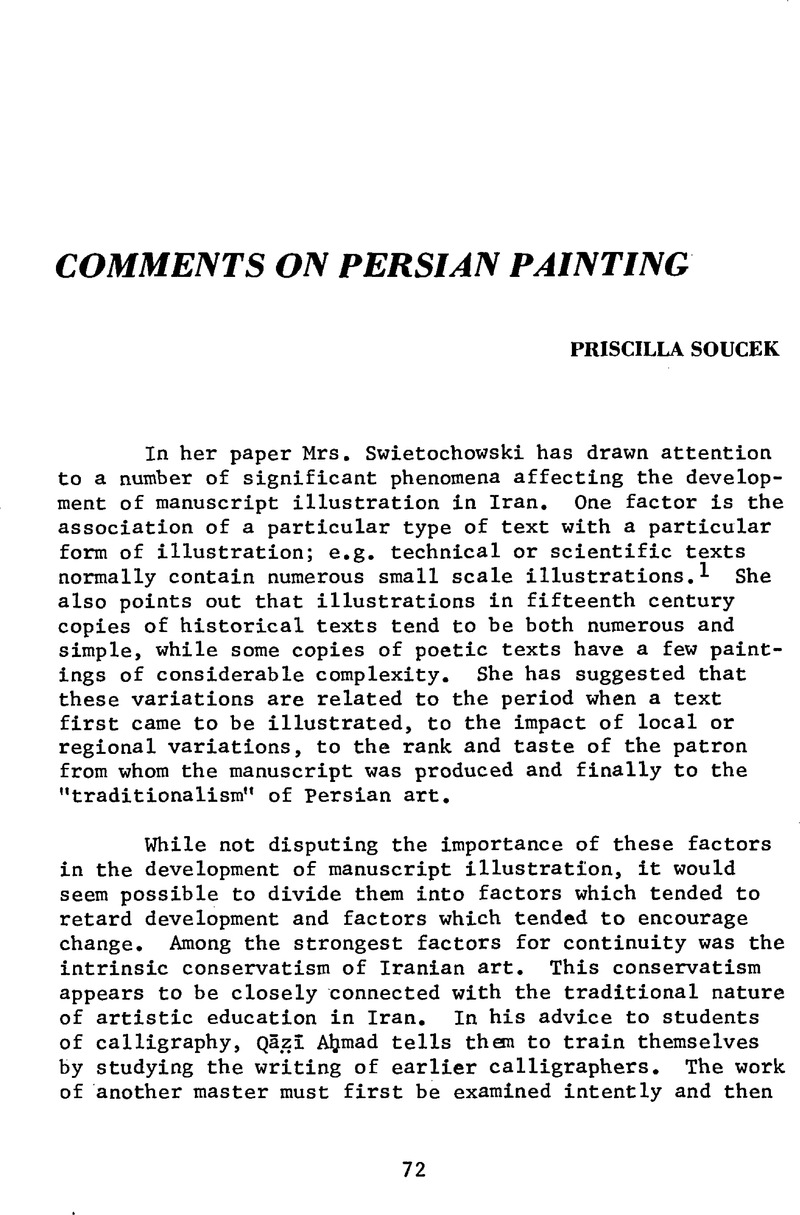No CrossRef data available.
Published online by Cambridge University Press: 01 January 2022

1. Concerning the background of this development, see Weitzmann, K., “The Greek Sources of Islamic Scientific Illustrations,” Archaeologica Orientalia in Memoriam Ernst Herzfeld (Locust Valley: 1952), pp. 244–66.Google Scholar
2. Qā![]() ī Aḥmad, Calligraphers and Painters, trans. Minorsky, V. (Washington: 1959), p. 117–18Google Scholar; Qā
ī Aḥmad, Calligraphers and Painters, trans. Minorsky, V. (Washington: 1959), p. 117–18Google Scholar; Qā![]() ī Mīr Aḥmad, Gulistān-i Hunar (Tehran: 1352), pp. 73–74Google Scholar “dar bayan-i naql-i khaṭṭ.”
ī Mīr Aḥmad, Gulistān-i Hunar (Tehran: 1352), pp. 73–74Google Scholar “dar bayan-i naql-i khaṭṭ.”
3. Istanbul, Topkapi Saray Library, Hazine 2153, fol. 98a. A study of this document is being prepared for publication by the author of this article.
4. Binyon, L., Wilkinson, J., Gray, B., Persian Miniature Painting (London: 1933)Google Scholar, pl. LXXXVIIB for the copy of Nanhā and pl. LXXXVIIA for its possible source.
5. Muḥammad, Dūst, A Treatise on Calligraphers and Miniaturists, ed. Chagatai, M.A. (Lahore: 1936), p. 24.Google Scholar
6. Welch, A., Shāh ᶜAbbās and the Arts of Isfahan (New York: 1973), pp. 33, 65Google Scholar & frontispiece; for further illustrations see Grube, E., The Classical Style in Islamic Painting (New York: 1968), no. 82.1-82.4Google Scholar
7. The great differences which can be found among different manuscripts of the same text can be seen by comparing the Demotte Shāhnāmah(Brian, D., “A Reconstruction of the miniature cycle in the Demotte Shāh-nāma,” Ars Islamica, vol. VI (1939), pp. 97–112Google Scholar) with that produced for Bāysunghur b. Shāh Rukh b. Tīmūr (UNESO, Iran: Persian Miniatures (Greenwich, Conn: 1956)Google Scholar, pls. I-IX) and the Shāhnāmah of Shāh Ṭahmāsp (Welch, C., A King's Books of Kings (New York: 1972Google Scholar).
8. M. Ipsiroglu has published a collection of isolated paintings which may have belonged to a variety of manuscripts, but even the nature of the text illustrated is difficult to ascertain (Saray-Alben (Wiesbaden: 1964), pp. 35-67.
9. For example compare a painting from a Shāhnāmah manuscript and one from a historical text, pls. XXIX and XXXII in Stchoukine, I., Les peintures des manuscrits timurides (Paris: 1954).Google Scholar
10. For siege scenes see Blochet, E., Musulman Painting (London: 1929)Google Scholar,pls. LVII and XCIV; for throne scenes see Stchoukine, op. cit., pls. LV and LXXVII.
11. Chester Beatty Persian Ms. 144, fol. 157b. Arberry, A., Minovi, M. and Blochet, E., The Chester Beatty Library; A Catalogue of the Persian Manuscripts and Miniatures vol. I, pp. 79–80.Google Scholar For an example of the same scene used to illustrate a Niẓāmī manuscript, see Robinson, B., “Prince Bāysunghur's Niẓāmī,” Ars Orientalis, vol. II (1957)Google Scholar, fig. 8. Reproduced through the courtesy of the Chester Beatty Library.
12. For the page belonging to the Metropolitan Museum from a Niẓāmī manuscript, see Ibid., fig. 9.
13. Dublin, Chester Beatty Library, Persian Ms. 119, fol. 14a. Arberry, op. cit., vol. I, pp. 38-39. Reproduced through the courtesy of the Chester Beatty Library.
14. Stchoukine, op. cit., pl. LXXV, pp. 72-74.
15. A letter written by Ibrāhīm al-Sābiᶜ for Bakhtiyār to a Turkish retainer gives an indication of these ceremonies: “You continued to disregard you duties and show disobedience so much that you altogether ceased to be present in our assembly (majlis) and stopped riding along with our retinue.” (Kabir, M., The Buwayhid Dynasty of Baghdad (Calcutta: 1964), p. 176Google Scholar). A similar list of activites is given in a qaṣīdah of Minuchihri Damghāni: “Cet Emir illustre qui, tantôt se mêle aux batailles, tantôt siége dans les conseils du Prince et tantôt se livre à la chasse” (12th Qaṣīdah--Dedicated to Emir Bakhtiyār, A. Biberstein-Kazimirski, Minoutcheri (Paris: 1886), p. 31, line 7 (Perisan text, p. 178 (trans). For a group of retainers on horseback see Survey of Persian Art, ed. Pope, A. (Oxford: 1939), pl. 667Google Scholar; for an audience, Ibid., pl. 659; for a hunting scene, Ibid., pl. 674.
16. The Metropolitan Museum of Art, Gift of Horace Havemeyer, 1941, the H.O. Havemeyer Collection. Accession no. 41. 119. 1. The bowl is dated to 1210 A.D.
17. Sourdel, D., “Questions de Ceremonial ᶜAbbaside,” Revue des Etudes Islamiques, vol. 28 (1960), pp. 132 & 142.Google Scholar
18. A good example of the range of princely activity can be seen in the frontispiece to various volumes of an early thirteenth century set of Kitāb al-Aghānī. They include a procession, a hunt and various throne scenes. (Rice, D.S., “The Aghani Miniatures and Religious Painting in Islam,” Burlington Magazine, vol. 95 (1953), pp. 128–134Google Scholar, figs. 14-19. (The Hunt is unpublished.)
19. Grube, op. cit., pl. 7.
20. Stchoukine, op. cit., pp. 33-34 and pls. IV-VI. British Museum Add. 18113.
21. Ibid., pl. VII.
22. Add. 18113, fol. 45b. This painting is reproduced through the courtesy of the Trustees of the British Museum.
23. Since the text of Khwājū Kirmānī's poetry is unpublished, these comments are based on the verses describing this incident in Türk ve Islām Eserleri Müzesi, no. 1949, fols. 213-14. For a general discussion of this manuscript, see Cig, K., “Türk ve Islām Eslerleri Müzesindeki Miniatürlü Kitaplarin Katalogu,” Ṣarkiyat Mecmuasi, III (1959), pp. 71–72.Google Scholar
24. Vienna, Austrian National Library, N.F. 382, fol. 32a. This painting is reproduced through the courtesy of the Austrian National Library. Concerning this manuscript see Wellesz, E., “Eine Handscrift aus der Blütezeit Frühtimuridischer Kunst,” Wiener Beiträge zur Kunst- und Kulturgeschichte Asiens, vol. X (1936), pp. 3–20Google Scholar; for the hunt see fig. 2.
25. For a reproduction of the painting of this subject in the Metropolitan Museum, see Ibid., fig. 4.
26. Ibid., p. 14-16.
27. For a discussion of Yūsuf and his relationship to Bāysunghur, see Browne, E., A Literary History of Persia (Cambridge: 1956), vol. III, pp. 498–501.Google Scholar